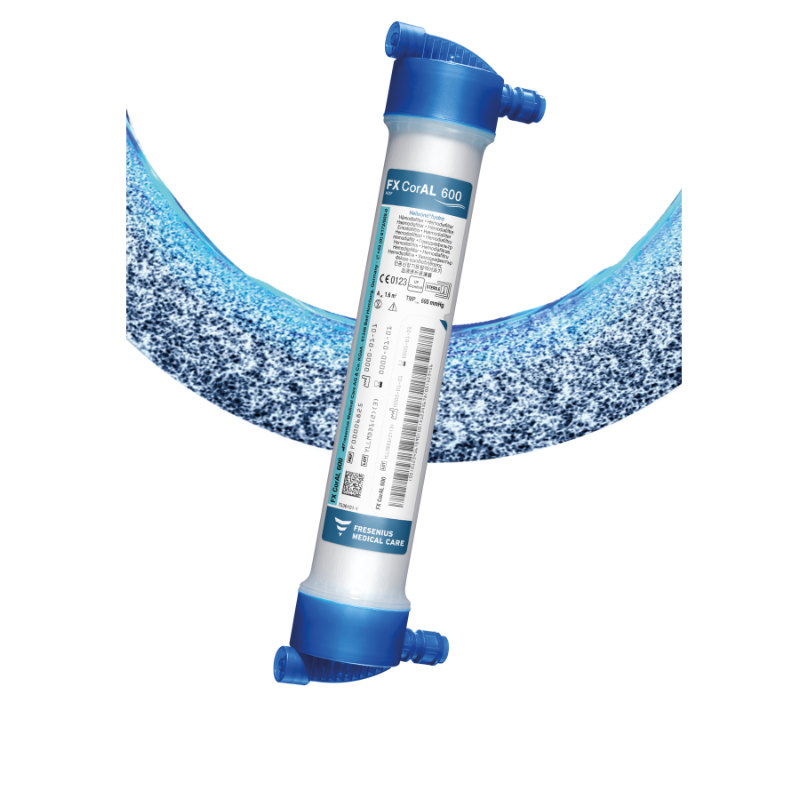Visit the FX CorAL website to learn more.
FX Dialyzers
FX portfolio
All FX Dialyzers have the capacity to remove a broad range of uremic toxins, effectively retain endotoxins, and provide intrinsic biocompatibility.1
Simplified workflows
The FX Dialyzers are developed for system compatibility, perfectly fitting into automatic priming procedures with low rinsing volumes and short preparation times. In addition, there is no need to turn any FX Dialyzer during the priming procedure. Moreover, the FX Dialyzers have a removable label that can easily be attached to patient records, allowing for quick documentation.
Simplified workflows, user-friendly handling and short preparation time support the nursing staff’s daily work — freeing up resources to focus more on patients.
Adding value across the entire life cycle
Fresenius Medical Care has implemented an approach based on the Life Cycle Assessment (LCA) methodology, which follows the structure and requirements of EN ISO 14040/44: 2006:
- Comprehensive assessment of a product’s environmental impact across its full life cycle, from materials supply to manufacturing, distribution, use and final disposal
- Identification of improvement opportunities through environmentally sound processes, materials and design choices.
Lightweight material is essential for environmental sustainability
The advanced housing material of any FX Dialyzer is made of environmentally friendly and lightweight polypropylene. Due to the advanced material, FX Dialyzers up to 50% lighter (before treatment) than dialyzers made of polycarbonate22
This may result in improved end-of-life management by producing less waste23 and contributing to cost savings.
Improved eco-performance
Across 15 environmental impact categories24, the overall eco-performance of an FX Dialyzer (FX classix 80) is notably better — on average by 42 % — compared to a reference dialyzer made from polycarbonate (HF 80S).25
Related content
In this section:
1 Wagner S. et al., Nephrology Dialysis Transplantation (2017); 32 (3): iii615.
2 Bock A. et al., J Am Soc Nephrol (2013); 24: SA-PO404.
3 Maduell F. et al., Blood Purif. (2014); 37(2): 125-130.
4 Lim P. S. et al., Artif Organs (2017); Nov 27. doi: 10.1111/aor.13011.
5 Schindler R. et al., Clin. Nephrology (2003); 59: 447–454.
6 Weber V. et al., Artif Organs (2004); 28(2): 210-217.
7 Chazot C. et al., Nephron (2015); 129: 269-275.
8 Tsai I.J. et al., Pediatr Nephrol (2014); 29: 111–116.
9 Data from Fresenius Medical Care Deutschland GmbH: Comparison clearance values F8 HPS (effective surface area 1.8 m2) versus FX 8 (effective surface area 1.4 m2).
10 Ronco C., Nissenson A. R., Blood Purif (2001); 19: 347-352.
11 Ronco C. et al., Kidney International (2002); 61 (80): 126-142.
12 Külz M. et al., Nephrol Dial Transplant (2002); 17: 1475-1479.
13 Mandolfo S. et al., The International Journal of Artificial Organs (2003); 26 (2): 113-120.
14 Allard B. et al., Le Pharmacien Hospitalier et Clinicien (2013); 48 (4): 15-21.
15 Shintani H., Biomedical instrumentation & technology (1995); 29 (6): 513–519.
16 Hirata N. et al., Radiation Physics and Chemistry (1995); 46 (3): 377–381.
17 Golli-Bennour E. E. et al., International urology and nephrology (2011); 43 (2): 483–490.
18 Azzabi A. et al., Néphrologie & Thérapeutique (2014); 10 (5): 318.
19 Golli-Bennour E.E et al., World J Nephrol Urol (2017); 6 (1-2): 14-17.
20 da Silva Aquino K. A., INtechOpen (2012); www.intechopen.com/books/gamma-radiation/sterilization-by-gamma-irradiation (27.04.2018).
21 Dawids S., Handlos V. N., Developments in hematology and immunology (1989); 347–368.
22 Unpublished data from Fresenius Medical Care Deutschland GmbH: Internal calculation based on weight measurements before treatment of FX Dialysers versus F-series dialysers.
23 Unpublished data from Fresenius Medical Care Deutschland GmbH: Internal calculation based on weight measurements of FME FX classix 80 versus FME HF 80S. The typical number of treatments in most clinics is approximately 10,000 per year; this results in about 1,600 kg less waste being produced annually with FX classix 80 when used on FME 5008 CorDiax machine.
24 EC-JRC-IES (2011): ILCD handbook – Recommendations for LCIA in the European context. Source: publications.jrc.ec.europa.eu/repository/handle/JRC61049 (all 15 environmental impact categories with recommendation in table 1 of this ILCD handbook have been evaluated).
25 Unpublished data from Fresenius Medical Care Deutschland GmbH internal study (2018): Comparative life cycle assessment of selected FME dialysers. Eco-performance is always calculated versus baseline product (FME HF 80S); long distance scenario illustrated.
26 Melchior, P. et al. (2021). Complement activation by dialysis membranes and its association with secondary membrane formation and surface charge. Artificial Organs, 00, 1-9. https://doi.org/10.1111/aor.13887
27 Zawada, A. et al. (2021). Polyvinylpyrrolidone in hemodialysis membranes: Impact on platelet loss during hemodialysis. Hemodialysis International, 25, 1– 9. https://doi.org/10.1111/hdi.12939
28 Ehlerding, G. et al. (2021). Performance and hemocompatibility of a novel polysulfone dialyzer: a randomized controlled trial. Kidney360, 2(6), 937-947 https://doi.org/10.34067/KID.0000302021
29 Ehlerding, G. et al. (2021). Randomized comparison of three high-flux dialyzers during high volume online hemodiafiltration – the comPERFORM study, Clinical Kidney Journal; sfab196. doi.org/10.1093/ckj/sfab196

















